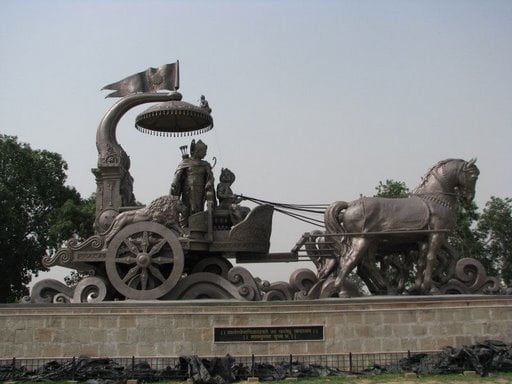The Kurukshetra War, described in the Indian epic Mahabharata
It is a war between two groups of cousins, the Kauravas and the Pandavas, for the throne of Hastinapura.
The war takes place over 18 days and is described in great detail in the Mahabharata.
The following are some of the rules of war that were agreed upon by both sides:
- Fighting must begin no earlier than sunrise and end precisely at sunset.
- Multiple warriors may not attack a single warrior.
- Two warriors may duel, or engage in prolonged personal combat, only if they carry the same weapons and they are on the same mount (no mount, a horse, an elephant, or a chariot).
- No warrior may kill or injure a warrior who has surrendered.
The Kurukshetra War is significant for several reasons:
- Religious Significance: The Kurukshetra War is considered to be a Dharmayuddha, or a righteous war, fought to uphold Dharma (righteousness) and prevent Adharma (unrighteousness).
- Philosophical Significance: The Bhagavad Gita, which is included in the Bhishma Parva of the Mahabharata, is a central text in Hindu philosophy and is considered to be one of the most important philosophical works in world literature.
- Historical Significance: The Kurukshetra War is believed to have taken place around 3102 BCE according to popular astronomical study. It is also considered to be one of the longest wars in human history, lasting for 18 days and involving millions of soldiers.
The following are some of the main characters in the Mahabharata:
Arjuna: One of the Pandava brothers and a central character in the Mahabharata. He is also the protagonist of the Bhagavad Gita, which is included in the Bhishma Parva.
Krishna: A major deity in Hinduism and a central character in the Mahabharata. He is Arjuna’s charioteer and mentor during the Kurukshetra War.
Bhishma: The commander in chief of the Kauravan armies.
Duryodhana: The eldest of the Kaurava brothers and one of the primary antagonists in the Mahabharata.
Yudhishthira: The eldest of the Pandava brothers and one of the primary protagonists in the Mahabharata.
Karna: A warrior who fights on behalf of Duryodhana and is known for his generosity and loyalty.
Drona: A teacher who instructs both Kauravas and Pandavas in warfare.
Shakuni: Duryodhana’s uncle who manipulates events behind the scenes throughout the Mahabharata.
Other notable characters include Draupadi, Nakula, Sahadeva, Abhimanyu, Ghatotkacha, Jayadratha, Ashwatthama, and Shalya.
Bhishma is one of the most important characters in the Mahabharata. He is the granduncle of the Pandavas and Kauravas, and he played a key role in the Kurukshetra War.
Bhishma was originally named Devavrata. He was the son of King Shantanu and the river goddess Ganga. When he was just a child, he made a vow of lifelong celibacy in order to fulfill his father’s wishes. This vow made him known as Bhishma, which means “immaculate” or “free from sin”.
Bhishma was a great warrior and a wise counselor. He was also a skilled diplomat and negotiator. He used his skills to help his father rule the kingdom and to prevent wars.
However, when Shantanu fell in love with Satyavati, a fisherwoman, Bhishma opposed the marriage because she was not of royal birth. In order to keep his vow of celibacy, Bhishma renounced his right to the throne and allowed Satyavati’s son, Vichitravirya, to become king.
After Vichitravirya died, Bhishma became the regent of the kingdom and ruled on behalf of his nephews, the Pandavas and Kauravas. However, the two cousins were always quarreling, and Bhishma was unable to prevent the Kurukshetra War.
During the war, Bhishma fought on the side of the Kauravas. He was a formidable warrior and he killed many Pandava soldiers. However, he was eventually shot by Arjuna with a special arrow that pierced his chest and pinned him to the ground.
Bhishma remained on the battlefield for several days, refusing to die until the war was over. He finally gave up his life when he saw that the Pandavas were winning.
Bhishma is a complex and tragic figure. He was a great warrior and a wise counselor, but he was also bound by his vow of celibacy, which ultimately led to the Kurukshetra War. His story is a reminder of the importance of choice and the consequences of our actions.
The sixth book of the Mahabharata, the Bhishma Parva, is dedicated to Bhishma’s life story. It tells of his birth, his vow of celibacy, his role in the Kurukshetra War, and his final days. The Bhishma Parva is a valuable source of information about Bhishma’s character and his role in the Mahabharata.
Here are some of the most famous stories from Bhishma’s life:
- The story of his vow of celibacy.
- The story of his opposition to Shantanu’s marriage to Satyavati.
- The story of his regency of the kingdom.
- The story of the Kurukshetra War.
- The story of his death.
Bhishma’s life is a fascinating and complex one. He is a tragic figure, but he is also a great hero. His story is a reminder of the importance of choice and the consequences of our actions.
